|
|
|
Sort Order |
|
|
|
Items / Page
|
|
|
|
|
|
|
| Srl | Item |
| 1 |
ID:
130884


|
|
|
|
|
| Publication |
2014.
|
| Summary/Abstract |
Emergency services such as police vehicles must provide reasonable service levels in order to ensure public safety. These services are typically provided by vehicles based at fixed locations. The number and placement of vehicles generally influences the quality of services offered. Increasing the number of vehicles is often limited by cost constraints; therefore the efficient deployment of such service vehicles is a crucial issue. Emergency service vehicles must be located in such a way that they may reach any demand point within a maximal response time. Current Practices in Abu Dhabi The traffic police in Abu Dhabi perform two major functions: enforcing traffic Abu Dhabi Police Plans laws and assisting road users. Within the Abu Dhabi Police department, the Directorate of Traffic and Patrols, which is in charge of all traffic aspects, allocates the traffic patrol vehicles to routine work and to special operations. The special operations vehicles are involved in escorting convoys and motorcades and in enforcing traffic laws and regulations through the deployment of patrol officers in specific areas at certain times, or in dealing with incidents and special events. The routine patrols perform all remaining tasks. At present, the patrol car allocation process is largely manual and relies heavily on the knowledge, experience and expertise of the dispatch operators. The operators divide the Emirate into geographic zones and allocate patrols based on their knowledge about the areas' needs and other criteria such as traffic flow patterns, population density, etc. In the event of an accident or call for assistance, the dispatcher calls on one of the patrol vehicles nearby and assigns it the task of dealing with the event.
|
|
|
|
|
|
|
|
|
|
|
|
|
|
|
|
| 2 |
ID:
169876


|
|
|
|
|
| Summary/Abstract |
As part of Germany's energy transition, enormous efforts are being made to transform the German energy supply to renewable energies. While much of the energy supply from renewables is wind and solar power, biogas contributes on third position a considerable share due to substantial state subsidies. The transformation to renewable energies leads to notable landscape changes that should be taken into consideration when studying the acceptance of renewable energy plants. We do this by adding spatial information to data from an online survey (N = 942) questioning the acceptance of biogas plants. The density of and proximity to existing biogas plants as well as the intensity of maize cultivation in the vicinity of respondents is integrated into the analysis together with more conventional influencing factors such as place attachment and attitudes. Results show that attitudes have the strongest explanatory power but spatial variables, particularly maize intensity, contribute significantly, too. Place attachment does not show reliable effects. The results demonstrate that spatial data can be useful in the analysis of survey data, for instance, in an environmental context. They also show that diversification of the raw materials used for fermentation in biogas plants might be an important factor in improving their acceptance.
|
|
|
|
|
|
|
|
|
|
|
|
|
|
|
|
| 3 |
ID:
117331


|
|
|
|
|
| Publication |
2013.
|
| Summary/Abstract |
In the European Union, electricity production from wind energy is projected to increase by approximately 16% until 2020. The Austrian energy plan aims at increasing the currently installed wind power capacity from approximately 1 GW to 3 GW until 2020 including an additional capacity of 700 MW until 2015. The aim of this analysis is to assess economically viable wind turbine sites under current feed-in tariffs considering constraints imposed by infrastructure, the natural environment and ecological preservation zones in Austria. We analyze whether the policy target of installing an additional wind power capacity of 700 MW until 2015 is attainable under current legislation and developed a GIS based decision system for wind turbine site selection.Results show that the current feed-in tariff of 9.7 ct kW h-1 may trigger an additional installation of 3544 MW. The current feed-in tariff can therefore be considered too high as wind power deployment would exceed the target by far. Our results indicate that the targets may be attained more cost-effectively by applying a lower feed-in tariff of 9.1 ct kW h-1. Thus, windfall profits at favorable sites and deadweight losses of policy intervention can be minimized while still guaranteeing the deployment of additional wind power capacities.
|
|
|
|
|
|
|
|
|
|
|
|
|
|
|
|
| 4 |
ID:
098625


|
|
|
|
|
| Publication |
2010.
|
| Summary/Abstract |
This paper identifies the potential for concentrated solar power (CSP) to generate electricity in a rural region of Western Australia. A review of policies designed to stimulate the contribution of renewable sources highlights the continued reliance upon fossil fuels to supply current and future electricity needs in Australia. Potential CSP sites are defined in the Wheatbelt region of Western Australia through overlaying environmental variables and electricity infrastructure on a high resolution grid using widely available datasets and standard geographical information system (GIS) software. The analysis confirms that CSP facilities can be sited over large areas of the Wheatbelt which can be tailored to local patterns of supply and demand. The research underlines the necessity to develop a policy regime which actively supports and stimulates CSP in order to capitalize upon its potential to facilitate rural economic development while contributing towards greenhouse gas emission reduction targets.
|
|
|
|
|
|
|
|
|
|
|
|
|
|
|
|
| 5 |
ID:
103595
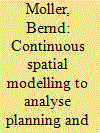

|
|
|
|
|
| Publication |
2011.
|
| Summary/Abstract |
Offshore wind resources appear abundant, but technological, economic and planning issues significantly reduce the theoretical potential. While massive investments are anticipated and planners and developers are scouting for viable locations and consider risk and impact, few studies simultaneously address potentials and costs together with the consequences of proposed planning in an analytical and continuous manner and for larger areas at once. Consequences may be investments short of efficiency and equity, and failed planning routines. A spatial resource economic model for the Danish offshore waters is presented, used to analyse area constraints, technological risks, priorities for development and opportunity costs of maintaining competing area uses. The SCREAM-offshore wind model (Spatially Continuous Resource Economic Analysis Model) uses raster-based geographical information systems (GIS) and considers numerous geographical factors, technology and cost data as well as planning information. Novel elements are weighted visibility analysis and geographically recorded shipping movements as variable constraints. A number of scenarios have been described, which include restrictions of using offshore areas, as well as alternative uses such as conservation and tourism. The results comprise maps, tables and cost-supply curves for further resource economic assessment and policy analysis. A discussion of parameter variations exposes uncertainties of technology development, environmental protection as well as competing area uses and illustrates how such models might assist in ameliorating public planning, while procuring decision bases for the political process. The method can be adapted to different research questions, and is largely applicable in other parts of the world.
|
|
|
|
|
|
|
|
|
|
|
|
|
|
|
|
| 6 |
ID:
150392


|
|
|
|
|
| Summary/Abstract |
South Africa and specifically its economically dominant province of Gauteng aim to reduce their influence on climate change. Especially the transport sector is seen as one of the key drivers of future greenhouse gas (GHG) emissions. This paper describes the methodology used to combine the application of two models in order to provide a basis for informed policy recommendation for GHG mitigation.
The TEMT model provides real world emission factors adapted to local conditions in Gauteng for numerous vehicle technology concepts. Those data feed into the TIMES-GEECO energy system model which identifies future technology use for different alternative scenarios. Finally, the scenario results are illustrated spatially using a GIS programme.
The results of the scenario analysis show that under implemented policies GHG emissions in Gauteng are likely to increase substantially. Pollutant emissions are currently high as a result of a comparably old vehicle fleet. The spatial display of these results shows where the traffic network is concentrated and the location of so-called emission hot-spots. Energy efficient policies for the transport sector of Gauteng can achieve a significant reduction of emissions and energy consumption. Alternative powertrains and the use of locally produced biofuels can play a significant role in such policies.
|
|
|
|
|
|
|
|
|
|
|
|
|
|
|
|
| 7 |
ID:
126558


|
|
|
|
|
| Publication |
2013.
|
| Summary/Abstract |
Recent audits have shown that anti-fuel poverty policies in the UK depend on loosely defined targeting and cannot accurately identify fuel poor households. New methods of targeting are necessary to improve fuel poverty policy. This paper uses Geographic Information System (GIS) techniques to evaluate the targeting of a home energy efficiency scheme small area level in Northern Ireland, based on the level of need. The concept of need is modelled using an area-based, multi-dimensional fuel poverty risk index. The characteristics and spatial distribution of household retrofits are explored. Policy activity and expenditure are compared with the level of need in an area. Results indicate that policy activity is only weakly associated with the level of need in an area, although policy appears to be well targeted in a few areas. Contrary to existing evidence, rural areas appear to be well served by policy, receiving above average numbers of retrofits and expenditure. There are typically two types of retrofit (major and minor). Most retrofits are minor and may not reduce fuel poverty. These results evidence the limitations of the current targeting system and suggest that there may be scope for improved policy implemented via a more proactive, area-based approach.
|
|
|
|
|
|
|
|
|
|
|
|
|
|
|
|
| 8 |
ID:
141886


|
|
|
|
|
| Summary/Abstract |
Map projections are mathematical methods for projecting spherical coordinates in the form of (φ, λ) to the map coordinates in the form of (X,Y) in Cartesian reference frame. Numerous methods for map projection have been derived and are being used for preparation of cartographic products. These map projections take into account specific position of the viewer on the datum surface for derivation of the map projections. A generic method for azimuthal map projection where the position of the viewer can be taken at an arbitrary point on the datum surface is derived. Using this generic method all the specific azimuthal map projections can be derived.
|
|
|
|
|
|
|
|
|
|
|
|
|
|
|
|
| 9 |
ID:
149133
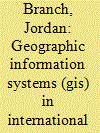

|
|
|
|
|
| Summary/Abstract |
Geographic Information Systems (GIS) are being applied with increasing frequency, and with increasing sophistication, in international relations and in political science more generally. Their benefits have been impressive: analyses that simply would not have been possible without GIS are now being completed, and the spatial component of international politics—long considered central but rarely incorporated analytically—has been given new emphasis. However, new methods face new challenges, and to apply GIS successfully, two specific issues need to be addressed: measurement validity and selection bias. Both relate to the challenge of conceptualizing nonspatial phenomena with the spatial tools of GIS. Significant measurement error can occur when the concepts that are coded as spatial variables are not, in fact, validly measured by the default data structure of GIS, and selection bias can arise when GIS systematically excludes certain types of units. Because these potential problems are hidden by the technical details of the method, GIS data sets and analyses can sometimes appear to overcome these challenges when, in fact, they fail to do so. Once these issues come to light, however, potential solutions become apparent—including some in existing applications in international relations and in other fields.
|
|
|
|
|
|
|
|
|
|
|
|
|
|
|
|
| 10 |
ID:
124668


|
|
|
|
|
| Publication |
New Delhi, Concept publishing company, 2006.
|
| Description |
xvii, 162p.Hbk
|
| Standard Number |
818069271X
|
|
|
|
|
|
|
|
|
|
|
|
Copies: C:1/I:0,R:0,Q:0
Circulation
| Accession# | Call# | Current Location | Status | Policy | Location |
| 057500 | 026.910285/PHA 057500 | Main | On Shelf | General | |
|
|
|
|
| 11 |
ID:
141192


|
|
|
|
|
| Summary/Abstract |
This study introduces a theoretical model of how insurgency develops as a function of reactive mobilization. The theory extends a classic distance-decay model by incorporating Kalyvas’ typology of violence. It implies that geographic conditions crucially determine the accuracy of applied violence and thereby its public perception, which in turn determines the actors’ ability to mobilize. As a first test of these effects, I propose a new geographic indicator that expresses the spatial accessibility of a country’s population for both central governments and peripheral insurgent movements. Two empirical implications of the theory are tested with a large-N data set on outcomes and casualties in insurgencies. The new indicator is significantly associated with both military outcomes and the number of casualties in insurgencies since 1970 and strengthens statistical predictions.
|
|
|
|
|
|
|
|
|
|
|
|
|
|
|
|
| 12 |
ID:
130885
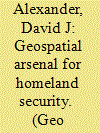

|
|
|
|
|
| Publication |
2014.
|
| Summary/Abstract |
Geospatial capabilities offer tremendous potential for driving new cost efficiencies and operational effectiveness for homeland security missions. Geospatial data and technology improve the ability of information technology applications and systems to enhance public security and provide for more effective situational awareness and delivery of a common operating picture. Geospatial information is often the common denominator that links disparate information together to reveal the necessary context and understanding required to connect the dots, and generate actionable information vital for effective decision-making. Location is everything to homeland security. Without geospatial context, we cannot understand where and how events are occurring, nor can we rationalise why they are occurring. The location component is the 'make or break' for nearly all homeland security operations from back office functions such as facilities management, to frontline operations in disaster response, border security, customs enforcement, critical infrastructure and threat reduction.
|
|
|
|
|
|
|
|
|
|
|
|
|
|
|
|
| 13 |
ID:
166985


|
|
|
|
|
| Summary/Abstract |
The continuous development of onshore wind farms is an important feature of the European transition towards an energy system powered by distributed renewables and low-carbon resources. This study assesses and simulates potential for future onshore wind turbine installations throughout Europe. The study depicts, via maps, all the national and regional socio-technical restrictions and regulations for wind project development using spatial analysis conducted through GIS. The inputs for the analyses were based on an original dataset compiled from satellites and public databases relating to electricity, planning, and other dimensions. Taking into consideration socio-technical constraints, which restricts 54% of the combined land area in Europe, the study reveals a nameplate capacity of 52.5 TW of untapped onshore wind power potential in Europe - equivalent to 1 MW per 16 European citizens – a supply that would be sufficient to cover the global all-sector energy demand from now through to 2050. The study offers a more rigorous, multi-dimensional, and granular atlas of onshore wind energy development that can assist with future energy policy, research, and planning.
|
|
|
|
|
|
|
|
|
|
|
|
|
|
|
|
| 14 |
ID:
165923


|
|
|
|
|
| Summary/Abstract |
According to many local and international reports, the risk of dust and sandstorms has increased significantly in Iraq, creating serious environmental and social problems. In this study Nineveh province was selected as the study area to investigate the relationship between the increase in such storms and drought expansion. In the study, storm-feeding regions and a probable storm path were detected using remote sensing and Geographic Information System (GIS). Standardized Precipitation Index (SPI) and runoff values were estimated and gathered as supplementary data with rainfall, temperature and storm frequency, where all the data were standardized to make them statistically comparable. Temporal variations analysis and Spearman’s rank correlation techniques were applied to summarize the strength relationships between the storm frequency and the entire dataset. Unusual behaviours were noticed and represented by decreasing runoff values and drought conditions fluctuating between moderate to extreme, where these behaviours were accompanied by an abnormal increase in storm frequency. Reasonable negative relationships equalled - 0.78 for rainfall and - 0.61 for runoff, while positive rank correlations equalled + 0.45 for temperature and + 0.16 for SPI. These results indicate a positive relationship between the storm frequency and increased drought areas, where 2.2% of the territory turned to drought and desert areas during the studied period between 1992 and 2017.
|
|
|
|
|
|
|
|
|
|
|
|
|
|
|
|
| 15 |
ID:
102214
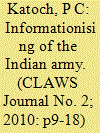

|
|
|
| 16 |
ID:
130882
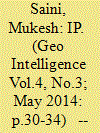

|
|
|
|
|
| Publication |
2014.
|
| Summary/Abstract |
Cyber warfare is very similar in nature to naval warfare. In international waters, navy encounters enemy warships, large merchant vessels, small merchant ships, fishing boats and guised surveillance ships from all directions. There are no borders to clearly establish that everything on the other side belongs to enemy. Though there are Sea-Lanes-of-Communication (SLOC) but two ports are actually on connectionless service and no ship is bound to follow SLOC. In cyberspace, IP address is the flag which every asset on the Internet displays but ruse is not uncommon. It is therefore necessary to identify the cyber assets positively in any cyber-conflict before any aggressive response is initiated. Wearing flag of convenience is common for sea vessels as well as cyber assets.
|
|
|
|
|
|
|
|
|
|
|
|
|
|
|
|
| 17 |
ID:
113419


|
|
|
|
|
| Publication |
2012.
|
| Summary/Abstract |
The development of new wind energy projects requires a thorough analysis of land use issues and constraints. At ETH Zurich, an analytical approach has been developed using a Geographic Information System (GIS) to define the location of suitable sites for wind projects and to predict their economic exploitable energy production. The purpose is to estimate the average Annual Energy Production (AEP), with a GIS customized tool, based on physical factors (environmental and anthropological constraints), the wind resource distribution and the technical specifications of the large-scale wind turbines currently present in the US market. Economics data and regulatory parameters are also included. The wind energy potential of the state of Iowa has been estimated: the resulting average AEP of Iowa is 914 TWh and the potential total installed capacity is 302 GW. A sensitivity analysis of the influence of the Power Purchase Agreement (PPA) shows that a PPA of 6.5 c$/kWh would enable to exploit the 85% of the buildable land with an IRR greater than 15%. This approach is applicable to both larger and more limited regions in order to support energy planners and wind farm developers to set energy strategies and to scout new profitable lands.
|
|
|
|
|
|
|
|
|
|
|
|
|
|
|
|
| 18 |
ID:
183150


|
|
|
|
|
| Summary/Abstract |
This article introduces CShapes 2.0, a GIS dataset that maps the borders of states and dependent territories from 1886 through 2019. Our dataset builds on the previous CShapes dataset and improves it in two ways. First, it extends temporal coverage from 1946 back to the year 1886, which followed the Berlin Conference on the partition of Africa. Second, the new dataset is no longer limited to independent states, but also maps the borders of colonies and other dependencies, thereby providing near complete global coverage of political units throughout recent history. This article explains the coding procedure, provides a preview of the dataset and presents three illustrative applications.
|
|
|
|
|
|
|
|
|
|
|
|
|
|
|
|
| 19 |
ID:
157582
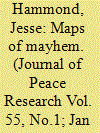

|
|
|
|
|
| Summary/Abstract |
Disaggregated studies of civil violence attempt to predict where violence is most likely to break out within states, but have been limited by a near-exclusive focus on political, economic, and accessibility-based factors in explaining local patterns of violence. These factors are important, but the calculus of military conflict does not focus solely on lootable resources or population distributions. Both states and insurgents try to exert control over geographic territory in order to increase their resource base and political legitimacy. Historic evidence suggests that groups use violence to contest control over strategically important locations that allow them to effectively attack and defend territory. I use GIS and social network analysis to operationalize strategic location based on the network of roads and population settlements that make up a country. I find that during conflicts, locations with high degree and betweenness centrality in the road network – in other words, locations that control access to other areas within the state – are significantly more likely to be fought over, even after controlling for a wide range of variables suggested by previous literature and testing for reporting bias. These findings expand on the previous body of literature studying disaggregated violence and show that the calculus of violence during civil conflict encompasses strategic considerations as well as economic, political, or topographic factors.
|
|
|
|
|
|
|
|
|
|
|
|
|
|
|
|
| 20 |
ID:
109406


|
|
|
|
|
| Publication |
2011.
|
| Summary/Abstract |
The necessity to reduce greenhouse gases emission produced by energy building consumptions and to cut the energy bill (mainly due to the use of fossil sources) leads to the employment of renewable energy sources in new planned scenarios. In particular, more and more often municipal energy and environmental plans pay great attention to the possibilities of employment of the solar technologies at urban scale.
Solar thermal and photovoltaic (PV) systems are, by far, the most suitable tools to be utilized in urban areas. Obviously, the proper adoption of such systems in buildings does call for the availability of calculation methods suitable to provide the actual level of exploitation of solar energy in urban layouts.
In this work, a procedure for evaluating the geographical energy potential of building roofs in urban areas is proposed; in particular, the amount of surface on the roof that could be used for the installation of systems able to capture solar radiation for the energy production is investigated. The proposed procedure is based on the use of the GIS technology and 3D cartography. The effectiveness of the proposed method is assessed by means of an application to the town of Palermo (Italy).
|
|
|
|
|
|
|
|
|
|
|
|
|
|
|
|
|
|
|
|
|